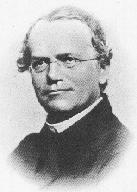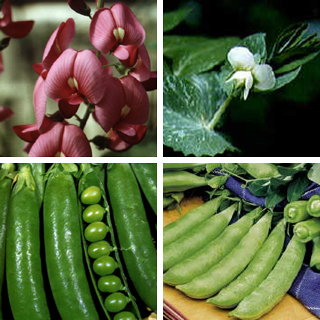BIOL 1400 -- Lecture Outline 16
"Facts do not cease to exist because they are ignored ." --Aldous Huxley
I. Once upon a time, there was a monk, living in a monastery in what was then
the town of Brünn in the Austro-Hungarian Empire. (The town is now in the
Czech Republic, and called Brno. . .)

- This monk, Brother Gregor Mendel by name, had studied at the University of Vienna
when he was younger, but had flunked out after two years. That did not, however,
keep him from an interest in botany -- he was a farmer's son, after all.
- As a monk, he taught at the monastery's high school. Now and then he did some
research, on agricultural pests, beekeeping, and weather.
- He also wondered about the problem of heredity, a problem that had the best minds in
Europe stumped.
- Mendel managed to get permission from the Abbot (the head of the monastery)
to do some experiments on plant breeding, in the monastery garden.
- Through an amazing stroke of luck, he chose to work on pea plants.
- Like all flowering plants, peas produce seeds when the female parts of their
flowers (which contain eggs) receive pollen (which contain sperm).
- Normally, pea flowers are completely enclosed by their petals at the
time they are pollinated. The result is that each flower fertilizes itself.
- Because pea flowers fertilize themselves, normally each pea plant produces
seeds that grow into plants that look just like the parent plant -- the peas "breed
true".
- A true-breeding plant with purple flowers, for instance -- if
it's left alone to self-fertilize -- will make seeds that all grow into purple-
flowered plants. This will continue for as many generations as you care to grow
the peas.
- Another advantage of using peas is that there were -- and are -- several different
strains of cultivated pea plant, with distinctive features that are easily told apart.

Top: Purple-flowered peas and white-flowered peas.
Bottom: Inflated-pod peas and constricted-pod peas.
These are four of the 14 strains of pea that Mendel used in his experiments.
- Mendel's experiments involved creating hybrids -- crosses between two
different strains.
- Brother Gregor could fertilize each flower artificially -- by cutting the
petals open, using a small paintbrush to put pollen from another plant on the
female parts of the flower, and then sealing the petals closed again with a bit
of wax.
- This meant that he could carefully control which pea plants fertilized
which. (An open flower could be pollinated by pollen from a random plant blowing
in the air.)
- And there were other advantages: peas didn't take up much room to grow, they
grew quickly, and you could eat them when your experiment was done.
- Gregor Mendel began his work in 1856.
- He experimented with crossing different strains of pea, such as purple-
flowered plants crossed with white-flowered plants. By 1863, he had made
287 different crosses between different strains of pea, and had grown and studied
about 28,000 plants.
- In 1865, Mendel presented his results in
this paper,
published in a local natural history society's journal. No one took much notice of
it at the time. . .
- . . . Mendel later gave up science, became Abbot (head of the monastery)
and spent the rest of his life governing the monastery, dying in 1884 at the
age of 61. . .
- . . . and it wasn't until 1900 than anyone realized what an amazing thing Mendel
had done.
II. Mendelian Genetics.
- Inheritance of Traits
- Let's look at one of the many crosses that Mendel performed. He crossed a purple-
flowered pea plant with a white-flowered pea plant. (Call this the parental
generation, or P for short.)
- He didn't get light-purple flowers, or pink flowers. All of the offspring
peas (the first filial generation, or F1 for short) were just as
purple as their purple parent. None were white.
- But when Mendel crossed two of the F1 plants, to get the
second filial or F2 generation, white-flowered
plants appeared in the F2 generation along with purple-flowered plants.
These white-flowered plants, if allowed to self-fertilize, would produce white
flowers for as many generations as Mendel could raise.
- Conclusion: Somehow the characteristic of white flower color had been passed
from the P generation to the F2 generation. It had been present in the
F1 plants, but had somehow been covered up, or masked, by the purple
color. White flower color never "masked" purple color.
- A trait like purple flower color, that can hide the existence of other traits, Mendel
called dominant. A trait like white flower color, that can be masked by
another trait and yet reappear later, Mendel called recessive.
- Inheritance isn't like mixing paint -- it involves passing on some sort of
discrete "particles" -- which Mendel called "elements," and which we now identify
as genes.
- So what? Animal and plant breeders already knew that you sometimes get
"throwbacks" to an ancestral trait. But what made Mendel's work so great was his
willingness to count the pea plants. . .
- Statistical Study of Traits
- In the F2 generation of the purple-white cross experiment, Mendel
noted that both purple-flowered and white-flowered plants appeared. Counting the
number of each revealed that there were about three times as many purple-flowered
plants as white-flowered plants.
- One-third of the purple-flowered F2 plants, when allowed to self-
fertilize, always produced only purple-flowered offspring.
- The other two-thirds of the purple-flowered plants, allowed to self-
fertilize, produced both purple-flowered and white-flowered offspring.
- Thus, the F2 generation broke down as follows: 25% true-breeding
purple, 25% true-breeding white, and 50% hybrid purple.
- These relationships held up for the F2 generation of every cross
Mendel made -- yellow and green peas, yellow and green pods, tall and dwarf plants,
etc.
- The explanation that Mendel offered was this:
- Every organism had its traits -- flower color, height, seed color, etc. --
determined by "particles" inside every cell, which we now call genes.
- There may be several different versions of each gene -- called alleles
of that gene. (Thus we can talk about the purple-flower allele, the white-flower
allele, etc.)
- Some alleles of one gene are dominant over other alleles of
that gene -- meaning that their presence masks the presence of the other,
recessive alleles.
- Each organism has, not one, but two genes for each trait.
- We can write alleles as single letters, with dominant ones as capitals
and recessives in lower-case. For instance, we can use P for the dominant
purple allele and p for the recessive white allele. A plant might be
PP, Pp, or pp. Both PP and Pp plants will
have purple flowers, and pp plants will have white flowers.
- Each parent normally passes on only one of its pair of genes to each offspring.
A true-breeding plant with PP alleles can only pass P alleles on
to its offspring. A pp plant can only pass on p alleles to its
offspring. However, a hybrid plant with Pp alleles can pass on either
P or p alleles to any one of its offspring.
Go to Previous Notes |
Return to Lecture Schedule |
Return to Syllabus |
Contact the Prof |
Go to Next Notes


